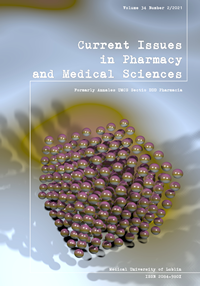Susceptibility in vitro of clinical Candida albicans isolates to the selected azoles
DOI:
https://doi.org/10.2478/cipms-2021-0015Keywords:
hematooncological patients, azoles, resistance, Candida albicansAbstract
Candida spp. is the most prevalent cause of fungal infection worldwide, and their increasing resistance to anti-fungal agents, especially to azoles, has become problematic. The aim of this work was to establish the susceptibility to fluconazole, itraconazole, voriconazole and posaconazole of 50 clinical C. albicans isolates from hematooncological patients. This has been evaluated using the following parameters: MIC (Minimum Inhibitory Concentration), MIC50 (MIC required to inhibit the growth of 50% of organisms), as well as MIC90 (MIC required to inhibit the growth of 90% of organisms). Susceptibility of the studied clinical isolates to all azoles was high, being 86% for itraconazole, 90% for fluconazole and posaconazole and 92% for voriconazole. The resistance rates ranged from 8% (voriconazole), to 12% (itraconazole). The emergence of azole-resistant yeast strains creates a necessity to determine and monitor the sensitivity of the isolated Candida spp., including C. albicans, especially in patients predisposed to life-threating fungal invasive disease.
References
1. Sharma J, Rosiana S, Razzaq I, Shapiro RS. Linking cellular morpho-genesis with antifungal treatment and susceptibility in candida pathogens. J Fungi. 2019;21;5(1):17.
2. Pristov KE, Ghannoum MA. Resistance of Candida to azoles and echinocandins worldwide. Clin Microbiol Infect. 2019;25(7):792-8.
3. Staniszewska M, Bondaryk M, Kowalska M, Magda U, Łuka M, Ochal Z, et al. Pathogenesis and treatment of fungal infections by Candida spp. Postep Mikrobiol. 2014;53(3):229-40.
4. de Oliveira Santos GC, Vasconcelos CC, Lopes AJO, Cartágenes M do S, Filho AKDB, do Nascimento FRF, et al. Candida infections and therapeutic strategies: Mechanisms of action for traditional and alternative agents. Front Microbiol. 2018;9:1351-74.
5. Guinea J. Global trends in the distribution of Candida species causing candidemia. CMI. 2014;20(6):5-10.
6. Nami S, Aghebati-Maleki A, Morovati H, Aghebati-Maleki L. Current antifungal drugs and immunotherapeutic approaches as promising strategies to treatment of fungal diseases. Biomed Pharmacother. 2019;110:857-68.
7. Karaaslan R, Aktaş E, Orhan F. An investigation of antifungal susceptibilities of the Candida species isolates from blood cultures using the sensititre yeastone microdilution method. Turk Hij ve Deney Biyol Derg. 2020;77(3):281-8.
8. Friedman DZP, Schwartz IS. Emerging fungal infections: New patients, new patterns, and new pathogens. J Fungi. 2019;5(3):67-86.
9. Fazal F. European Committee on Antimicrobial Susceptibility Testing and Clinical and Laboratory Standards Institute breakpoints - the only point that matters in candidemia? J Thorac Dis. 2019;11(9):1412-14.
10. Lei J, Xu J, Wang T. In vitro susceptibility of Candida spp. to fluconazole, itraconazole and voriconazole and the correlation between triazoles susceptibility: Results from a five-year study. J Mycol Med. 2018;28(2):310-3.
11. Whaley SG, Berkow EL, Rybak JM, Nishimoto AT, Barker KS, Rogers PD. Azole antifungal resistance in Candida albicans and emerging non-albicans Candida Species. Front Microbiol. 2017;7:1-12.
12. Diekema D, Arbefeville S, Boyken L, Kroeger J, Pfaller M. The changing epidemiology of healthcare-associated candidemia over three decades. Diagn Microbiol Infect Dis. 2012;73(1):45-8.
13. Pfaller MA, Rhomberg PR, Messer SA, Jones RN, Castanheira M. Isavuconazole, micafungin, and 8 comparator antifungal agents’ susceptibility profiles for common and uncommon opportunistic fungi collected in 2013: temporal analysis of antifungal drug resistance using CLSI species-specific clinical breakpoints and proposed epidemiological cutoff values. Diagn Microbiol Infect Dis. 2015;82(4):303-13.
14. Ying Y, Zhang J, Huang S, Liu F, Liu J, Zhang J, et al. Fluconazole susceptibility of 3,056 clinical isolates of Candida species from 2005 to 2009 in a tertiary-care hospital. Indian J Med Microbiol. 2015;1;33(3):413-5.
15. Enwuru C, Ogunledun A, Idika N, Enwuru N, Ogbonna F, Aniedobe M, et al. Fluconazole resistant opportunistic oro-pharyngeal candida and non-candida yeast-like isolates from HIV infected patients attending ARV clinics in Lagos, Nigeria. Afr Health Sci. 2008;8(3):142-8.
16. Yenisehirli G, Bulut N, Yenisehirli A, Bulut Y. In vitro susceptibilities of Candida albicans isolates to antifungal agents in Tokat, Turkey. Jundishapur J Microbiol. 2015;8(9):0-4.
Downloads
Published
Issue
Section
License
Copyright (c) 2021 Authors

This work is licensed under a Creative Commons Attribution-NonCommercial-NoDerivatives 3.0 Unported License.


